Jan Serra, 3 Minutes to Midnight – Conspiracies, ambition and a striking new adventure

- 1 Comment
Back in 2017, few if any had heard of Scarecrow Studio, an upstart indie developer with no games to their credit. But they blew everyone’s socks off with the first screenshots and teaser for their debut adventure, 3 Minutes to Midnight, dazzling us with its stunning hand-drawn artwork and the promise of classic point-and-click gameplay updated for modern gamers. And when a bunch of sockless supporters helped successfully finance the game through Kickstarter, it looked like smooth sailing to its expected launch in 2019.
And then… silence. Oh, the developers popped up often enough to assure us they were still working on the game, but updates were few and far between, and with little sign of progress, 3 Minutes to Midnight largely faded from view. For years.
And then… it was here! It was done! And it was ready for release! And looking better than ever, with a level of production quality that would rival any experienced team of big-name developers.
How the heck did that happen? Clearly the amount of work being put into the game was in inverse proportion to the amount of time spent promoting it all this time. So now that it’s finished (or is it? The team has been feverishly updating the game with new fixes and requested features even after release), I caught up with the game’s director Jan Serra to talk about everything that’s been happening behind the scenes, and what to expect of this jaw-dropping new adventure seven years in the making.
Hi, Jan. Welcome to the Adventure Game Hotspot, and congrats on the release of 3 Minutes to Midnight! What an exciting – and perhaps anxious – time this must be for the team.
Thank you so much, and thanks to Adventure Game Hotspot for the invite! It's surreal to finally release 3 Minutes to Midnight after seven years. It's been quite the emotional rollercoaster. When you work on something for so long, it really becomes a part of you. As newbies in game development, we weren't sure what to expect, but seeing people loving the game is really heartwarming. Watching players talk about the story, share quotes, uncover secrets, discuss references, and laugh at lines we wrote years ago—it makes all those sleepless nights worth it!
3 Minutes to Midnight impressed everyone when it was first announced, but a long time has passed since then, so please give us a refresher on what the game is about.
3 Minutes to Midnight is a comedy point-and-click adventure set in the late 1940s. It all starts with a mysterious explosion that shakes a small sleepy town in New Mexico. For some reason, no one—including our protagonist, Betty—remembers who they are or what happened to them. Determined to uncover the truth, Betty sets off on a journey filled with mysteries, bizarre encounters, and supernatural events. With a strong desire to help others, she'll meet a bunch of wacky characters who might not even be who they think they are! And if that wasn't complicated enough, add shady government conspiracies to the mix. But is the Army really pulling the strings? That's up to you to discover.
We’ve blended traditional adventure gameplay with a sci-fi plot filled with humor. It's divided into five main chapters, giving you over 20 hours of gameplay, where every decision you make and every clue you uncover will play a crucial role in how the story plays out.
As welcome as the news was, I think all of us were shocked by the sudden announcement that 3 Minutes to Midnight was nearly ready for release after you’d been so quiet about the game’s progress for so long. I don’t want to dredge up bad memories, but you described that time on Kickstarter as a period where “everything that could go wrong went wrong.”
.jpg?f=articleside)
We know the sudden announcement of 3 Minutes to Midnight's release took everyone by surprise. As a small team, we took on a very ambitious project, and along the way, we faced more challenges than we expected. We stepped back from social media to focus all our energy on finishing the game.
One of the biggest hurdles was when we chose to expand the game halfway through development. We wanted to make it truly special by adding multiple endings and different puzzle solutions. This wasn't part of our original scope, so we had to redo large parts of the game, sometimes even starting from scratch. This extended our timeline and stretched our resources, but we felt it was worth it to create an experience truly unique for players.
At times, it felt like Murphy's Law was an extra member of our team, with anything that could go wrong going wrong. But looking back, we're proud of how we overcame all these obstacles. We've learned so much from this journey, and we're really happy to deliver the game to players exactly as we imagined and without bugs.
We would like to take this opportunity to thank everyone who patiently supported us throughout this time. Now that it's in players' hands and the feedback has been positive, we feel that all the challenges were worth it.
To face all that and still end up with something so content-rich, so polished-looking is remarkable, especially for a first-time developer. If you could go back to your fresh-faced, naïve, seven-years-ago selves and offer them some advice, what would it be?
You know, if we could go back seven years and talk to our younger selves, we'd probably say, “How about building a treehouse first before attempting a skyscraper?” Jumping into such a complex game as our first wasn't the best decision, and it definitely hasn't been a walk in the park. But taking the easy route? Well, where's the fun in that? (smiles)
On a serious note, we were so eager to bring all our big ideas to life that we didn't realize we were creating a monster of a project. It's tempting to pack all your big ideas into your first game, but that can quickly become overwhelming. Probably a smaller project would have let us enjoy the process more.
Sure, it’s no wonder it took longer than expected, because this is a really ambitious game. Even for an experienced team that would be a lot. After realizing what all was involved in expanding the game, did you ever (re)consider scaling back the scope of the design?
On paper, it all seemed manageable, but as we got deeper into development, the complexity increased exponentially.
We reached a point where we had to make a tough decision: either cut significant portions of the game—essentially throwing away three years of hard work—or push forward and make it happen. The story and gameplay were so intricately woven that removing even a single chapter would've unraveled key elements of the narrative and disrupted the entire experience we wanted to deliver.
Our team worked incredibly hard to keep everything on track. I personally dedicated every hour of my day to ensure that every aspect of the game met our high standards and that the team had the support they needed.
Our testers played a pivotal role in this journey. Their feedback made it clear that scaling back would've been a disservice not only to the game but to the players eagerly awaiting its release.
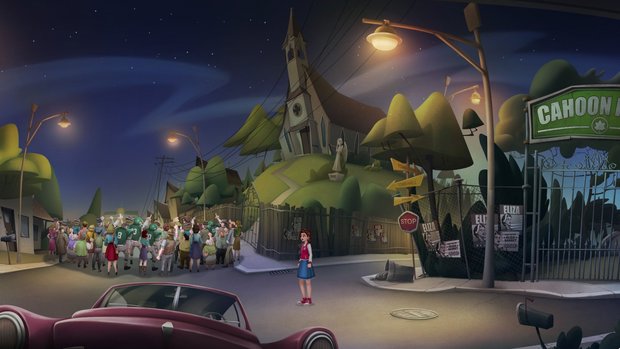
If I’m not mistaken, your team is based in Spain. Now, I’m no geography expert, but that puts you far from New Mexico, where the game takes place. Why set it in the American desert? And why the 1940s in particular?
I think the vast and mysterious American Southwest is the perfect setup for the adventure and mystery we wanted to create. When I was a kid, one of the first movies I saw was Them!, where nuclear tests in New Mexico turn ants into giant monsters—I thought that was so cool! I also really enjoyed classic movies like The Andromeda Strain, The Man Who Fell to Earth, and The Day the Earth Stood Still. Close Encounters of the Third Kind was one of my all-time favorites too. And of course, TV shows like The Twilight Zone and The X-Files really fascinated me.
I love all these classic sci-fi stories, and they had a big influence on making the New Mexico desert in the 1940s a main part of our game's story. This area has always been a hotspot for legends and conspiracy theories, which fits perfectly with our game's themes. We wanted to capture that sense of wonder and possibility—the same feeling you get when watching those classic movies that make you question what's really out there.
A funny thing we realized while testing the game was that while many older fans know these classic stories, younger players might not. This gave us a chance to reintroduce this iconic era with a fresh twist, mixing in humor and modern storytelling.
3 Minutes to Midnight seems like a conspiracy theorist’s dream, with all sorts of weird stuff happening that important people want kept hush-hush. It’s played here for laughs, but how about you? Think there’s any truth to aliens in Area 51, government cover-ups, or other popular rumors?
I don't personally believe that aliens have visited Earth or that there's a secret government of lizard people ruling the world (although, with the things you see on the news these days, this wouldn’t even be the weirdest thing). I think Area 51 is most likely just a base for highly advanced technology. Still, it's fascinating how easily simple events can spiral into the wildest conspiracy theories. For example, a weather balloon crash becomes a UFO sighting, and people’s imaginations take it from there. In 3 Minutes to Midnight, we loved playing with these ideas. We’ve filled the game with plenty of supernatural elements. From the Chupavacas—our playful twist on the Chupacabras—to a sheriff who's convinced there’s a secret group of criminal chipmunks running the world. No one in town believes these wild stories, but that doesn’t stop the sheriff from connecting the dots in his own crazy way.
The game features not one but two playable protagonists that seem quite different from each other: the plucky young amnesiac Betty Anderson and the local mayor, Eliza Barret. Please tell us a little about them.
Betty's a spirited, curious, and slightly mischievous teenager. Imagine a blend of Nancy Drew's inquisitiveness with a touch of Homer Simpson's lovable cluelessness. Waking up with no memory after the explosion, Betty is determined to figure out what's going on. Despite not always getting things right, she has a good heart and genuinely wants to help others.
Then we have Eliza, the town's mayor and Betty's mother. Eliza is smart, calm, and always in control. She's ambitious, dreaming of climbing the political ladder all the way to the presidency. Think of her as a chess player, always several moves ahead. Raised in a strict environment, Eliza believes that tough love is the way to prepare Betty for the real world.
Their relationship is complex. Betty seeks attention through pranks and mischief, longing for a closer connection with her mother. Meanwhile, Eliza struggles to express her affection, thinking that being firm is in Betty's best interest.
Betty's segments are filled with youthful energy and curiosity, while Eliza's provide a strategic and composed approach to unraveling the mystery.
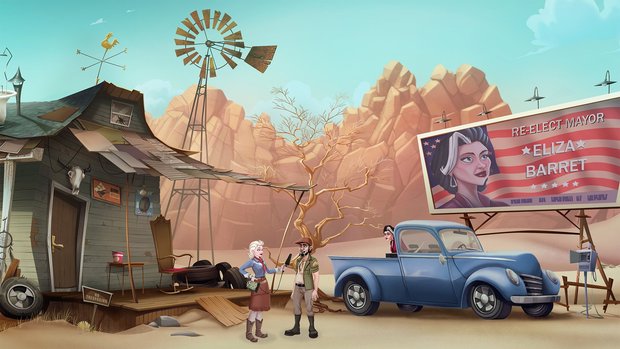
Presumably their stories interconnect at some point, but is there any tandem gameplay, or are they each pursuing their own goals, entirely independently of each other?
You play as one character at a time—first with Betty during the first two chapters, then with Eliza during one chapter, and then with Betty again during Chapters 4 and 5. Now, while Betty and Eliza are pursuing their own goals independently, their stories are deeply interconnected, and as you progress, you'll start to see how everything is linked.
But here's where it gets really exciting—we wanted to make sure that replaying the game offers you more than just the same old experience. Our goal was to reward curiosity and exploration, so we've packed it with layers that encourage you to dive back in. Each time you replay, you'll uncover new puzzles, meet new characters, and discover additional conversations and pieces of information. Even examining objects you've seen before might reveal new insights or hidden Easter eggs you didn't catch the first time around.
The title suggests there’s a countdown involved in the game, as you have limited time to save the world from impending disaster. Is there any actual time pressure, or is this all a very leisurely, traditional adventure game?
Despite what the name might suggest, there's actually no time pressure in the game. The title represents the looming danger within the story, symbolizing just how close things are to a major disaster.
3 Minutes to Midnight is a traditional point-and-click adventure that lets you play at your own pace. Some players have taken over 60 hours to explore everything, while others complete it in about 20 hours. Your choices definitely matter—they affect the story and lead to different endings—but you're free to take your time uncovering secrets, solving puzzles, and interacting with the characters.
And here's a fun little fact: there's a hidden ending that no one has discovered yet. If you find it, you could potentially finish the game in about 5-6 hours.
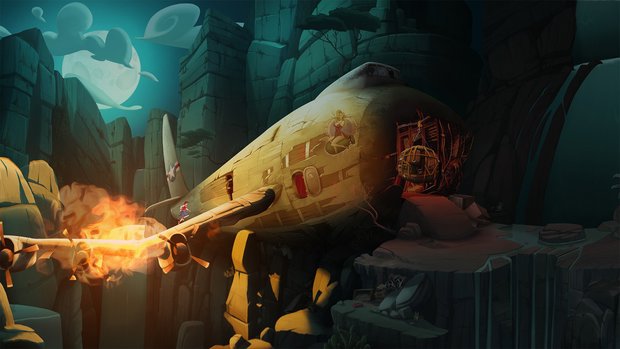
It’s clear that you’re fans of the genre classics. What sorts of adventures inspired you as designers of your own game?
My love for adventure games goes way back, and it’s certainly been a huge inspiration in designing 3 Minutes to Midnight. It all started with the classics from LucasArts, Sierra, Revolution, and Westwood Studios. My dad introduced me to these games. Almost every week, he’d bring me a new one, and we’d spend hours playing together. Like many whose first gaming experiences were with adventure titles, they left a lasting mark on me, and remembering them always brings back fond memories.
When it comes to storytelling, Grim Fandango stands out as one of the best. Its narrative depth and unique characters were groundbreaking at the time. With 3 Minutes to Midnight, I wanted to create something similar—interesting characters and layered plots that go beyond a simple, straightforward story. I aimed to build a world where players get invested not just in solving puzzles but in uncovering deeper mysteries.
In terms of humor, I’ve always loved the silliness and lightheartedness of games like Monkey Island, Day of the Tentacle, and Toonstruck, among others. Many point-and-click adventures lean toward serious themes, and writing comedy is challenging—it’s subjective and complex. But I wanted to make a game that would make players laugh, chuckle, and take their minds off things, even if just for a few hours.
One of my all-time favorites is Sam & Max Hit the Road. The dynamic between Sam and Max was so engaging, and it showed me how powerful well-crafted character relationships can be. In 3 Minutes to Midnight, we aimed to create that same kind of chemistry, where the character interactions feel natural and fun, and contribute to both the humor and the story.
For puzzle design, Monkey Island 2 and Monkey Island 3 had a huge influence. We aimed for puzzles that strike a balance—not too easy to breeze through, but not so hard that players need a guide at every step. There are a couple of big, challenging puzzles (I couldn’t resist!), but we wanted to avoid players getting stuck and disconnected from the story. It’s a delicate balance, like humor—what’s easy for some might be tough for others—but based on the feedback we’ve received, I think we hit the right note.
I also loved games like Space Quest, especially Space Quest IV. I enjoyed the challenge of navigating a world where failure could lead to death. However, in 3 Minutes to Midnight we took a different approach. Instead of killing the player and forcing them to reload, we decided to keep the game moving forward. If you fail a puzzle, there are consequences, but they don’t stop your progress. This way, players stay immersed in the story without the frustration of constantly restarting.
How about other mediums, beyond the sci-fi influences you mentioned earlier?
I'm really into classic books like Treasure Island, Frankenstein, and The Adventures of Huckleberry Finn. Their timeless stories always grab my attention, and we wanted to bring that same sense of timelessness to our game.
Being born in the '80s, I'm heavily influenced by movies from the '80s and '90s. We've hidden over 200 references from films like Back to the Future, Ghostbusters, The Princess Bride, Buckaroo Banzai—you name it! These movies gave us incredible childhoods, and now we're paying homage to them by adding this fun aspect to our game.
For comedy, we wanted our game to be lighthearted and not take itself too seriously. We're definitely influenced by shows like South Park, Family Guy, Futurama, and Archer, as well as comedians like Dave Chappelle and Bill Burr.
All these different influences came together to create 3 Minutes to Midnight, and we really hope players enjoy all the little touches we've added from the things we love. For example, we’ve hidden a moment where Betty turns into Gollum, Christine (the car from Stephen King's novel) comes to life, and even a Weeping Angel from Doctor Who makes an appearance—to name a few. We're excited to hear how these elements resonate with our audience and see what other surprises players uncover!
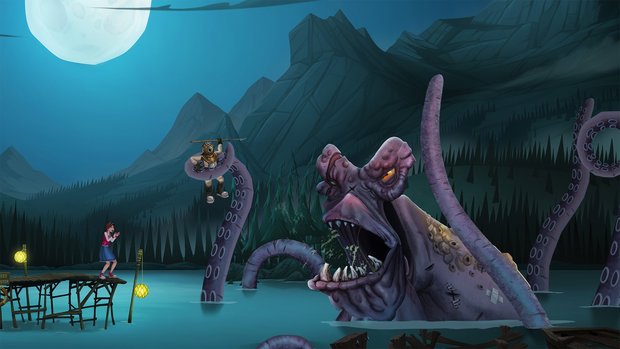
I know you’ve got a lot of people nodding in approval with those choices. But you’ve clearly worked hard to give 3 Minutes to Midnight its own distinct personality as well. What makes your game different from others point-and-click adventures out there?
One thing that makes our game stand out is how much care we put into the characters and how alive they feel to the player. We wanted them to be more than just people you meet once; they continue to engage with you, offering more depth and connection beyond just moving the story forward. Let me tell you, after spending so many hours writing for them, they felt like real people to us, and we already knew how they should sound and behave. This made the casting process quite challenging because we were looking for voices that matched exactly the ones we had in our heads. It was really tough, but when everything came together, it was incredibly satisfying to hear them in the game.
Another aspect we’re really proud of is the multiple solutions to the puzzles. One of the funniest moments we had after the release was talking to a journalist who was really happy, telling us how he found the four different solutions to solve the Kraken puzzle. Then we told him, “fun fact: there's a fifth solution.” He couldn’t believe it and went right back to find it. Seeing that excitement and enjoyment made us feel really good about what we created.
Putting things in perspective, the decision to include multiple solutions was a big risk, not only because it extended the development time and increased the cost of the project but also due to the complexity of designing so many puzzles to break away from the usual linearity of the genre. Some players might worry about missing the "best" option, but we made sure all the alternatives are enjoyable. We encourage everyone to play in the way that feels right to them and not to worry about the different alternatives.
Now that more people have had a chance to play the game, how has player feedback impacted the updates and improvements you've made to the game since launch?
We’re really happy with the feedback we’ve received so far! We’re grateful for all the comments, both good and bad. They’ve helped us make the game better in many ways. Since launch, we’ve released eight patches to improve the game based on the feedback. We’ve removed unnecessary dialogue, improved the pacing of some scenes, cut down on jokes and lines that were dragging, and added a better ending. Another thing we're really excited about is the new epilogue we've added to the game. It provides a satisfying conclusion for all the main characters—something our players have been asking for.
Currently, we’re working on improving the functionality of the progress tracker to help players understand different outcomes and navigate the various endings more easily. We’re also adding more languages, Russian and Chinese, in our next major update!
Even though it’s not always easy to hear criticism, we know it’s important to give players what they want. At the end of the day, the game is theirs as much as it is ours.
Even after seven grueling years of development – or especially after seven grueling years of development – that’s an impressive commitment to keep striving to make the game better post-release. Where can people pick up 3 Minutes to Midnight for themselves?
Thank you so much! You can find 3 Minutes to Midnight on Steam, Xbox One, Xbox Series X/S, PlayStation 4, PlayStation 5, and Nintendo Switch right now. We're working on releasing it on GOG and the Epic Games Store soon, and we're also planning to bring it to mobile platforms sometime next year.

Thanks very much for sharing these glimpses behind the scenes with us, Jan. I congratulate you and your team on overcoming all those obstacles to make such a stunning-looking game that’s obviously more than just a pretty face! It’s probably hard to think of a time when you’re NOT working on this game any longer, but when you’re finally ready to look ahead, what’s in store next for Scarecrow Studio?
It’s hard to say. As I mentioned, right now we're putting all our focus on improving 3 Minutes to Midnight. We had started working on two more point-and-click games, but ultimately decided to cancel those projects. Right now, it seems like 3 Minutes to Midnight will be our first and last point-and-click adventure. We hope to continue making games, but we might look into different genres as we move forward.
Thank you again for having us, and we hope players enjoy what 3 Minutes to Midnight has to offer.


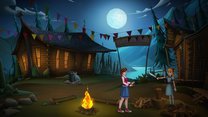
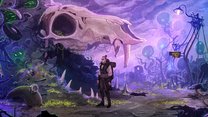
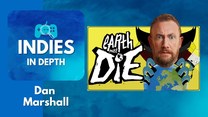
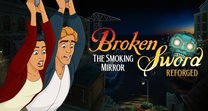



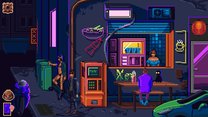
1 Comment
Want to join the discussion? Leave a comment as guest, sign in or register.
Really sad to hear there won’t be any more games from this team. 3 Minutes to Midnight is in my opinion one of the best point-and-click adventures I’ve played in years. It reminded me of Thimbleweed Park, but with its own unique charm. I love supporting adventure games and buy every one I can find, but it’s hard seeing this genre slowly fade away. There’s still so much talent out there, and I really hope we keep seeing more of these types of games in the future. Huge thanks to the devs for making such a great game!
Reply
Leave a comment